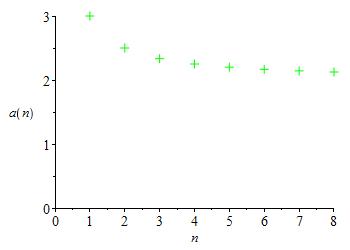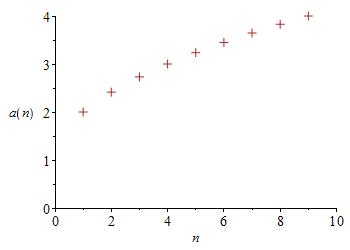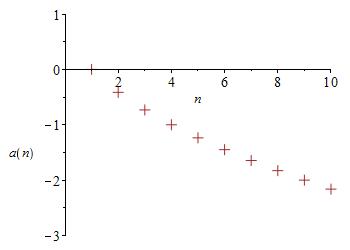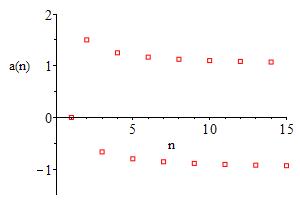18. Sequences
b1. Limits - Definition
The limit of the sequence \(a_n\), denoted \(\lim\limits_{n\to\infty}a_n\), tells what number the terms are approaching as we go further and further out in the sequence (as \(n\) gets arbitrarily large).
Plot the sequence \(a_n=\dfrac{2n+1}{n}\) for \(1\cdots8\) and guess its limit.
The plot is shown at the right. As \(n\) gets larger, the terms \(a_n\) are approaching \(2\). So we write: \[\lim_{n\to\infty}a_n =\lim_{n\to\infty}\dfrac{2n+1}{n}=2 \]

When we are given a sequence, the typical questions we ask are:
- Does the sequence have a limit?
- If so, what is the limit of the sequence?
- If not, is the limit infinite, (i.e. \(+\infty\) or \(-\infty\)) or oscillatory divergent (i.e. neither \(+\infty\) nor \(-\infty\))?
There is a precise definition of the limit of a squence, but it is beyond the scope of most classes. If you want to read about it, it is at the end of this chapter. However, it is sufficient to understand the following intuitive definition:
The sequence \(a_n\) has a limit if the
terms \(a_n\) get closer and closer to a finite number \(L\)
as \(n\) gets arbitrarily large. In that case, we say
\(\lim\limits_{n\to\infty}a_n\) exists and is equal to \(L\),
and we write:
\[\lim_{n\to\infty}a_n=L
\]
If a sequence has a limit \(L\), we say it is
convergent and that it
converges to \(L\).
If a sequence does not have a limit, we say it is
divergent or that it
diverges.
If the sequence diverges, it may still have an infinite limit.
If the terms \(a_n\) get arbitrarily large and positive as \(n\) gets arbitrarily large, then we say the sequence diverges to positive infinity (\(+\infty\)) or that the limit is \(+\infty\) and write: \[\lim_{n\to\infty}a_n=\infty \] If the terms \(a_n\) get arbitrarily large and negative as \(n\) gets arbitrarily large, then we say the sequence diverges to negative infinity (\(-\infty\)) or that the limit is \(-\infty\) and write: \[\lim_{n\to\infty}a_n=-\infty \] If the sequence is divergent but does not diverge to either \(\infty\) or \(-\infty\), then we say it is oscillatory divergent.
To say that the limit is plus or minus infinity does not say that the limit exists! It merely says the way in which it does not exist, i.e. the way in which it diverges.
The sequence \(a_n=1+\sqrt{n}\) diverges to \(\infty\) because \(1+\sqrt{n}\) gets arbitrarily large and positive as \(n\) gets large. Its plot is:

The sequence \(a_n=1-\sqrt{n}\) diverges to \(-\infty\) because \(1-\sqrt{n}\) gets arbitrarily large and negative as \(n\) gets large. Its plot is:

It is certainly possible to diverge without diverging to \(\infty\) or \(-\infty\).
Since the terms of the sequence \(a_n=(-1)^n+\dfrac{1}{n}\) oscillate between numbers which get closer to \(1\) and numbers which get closer to \(-1\); the sequence does not converge; it diverges. However, it does not diverge to \(\infty\) or \(-\infty\). So it is oscillatory divergent. Its plot is:

Plots are insufficient to determine a limit. However, examples and exercises appear on the next page.
Heading
Placeholder text: Lorem ipsum Lorem ipsum Lorem ipsum Lorem ipsum Lorem ipsum Lorem ipsum Lorem ipsum Lorem ipsum Lorem ipsum Lorem ipsum Lorem ipsum Lorem ipsum Lorem ipsum Lorem ipsum Lorem ipsum Lorem ipsum Lorem ipsum Lorem ipsum Lorem ipsum Lorem ipsum Lorem ipsum Lorem ipsum Lorem ipsum Lorem ipsum Lorem ipsum